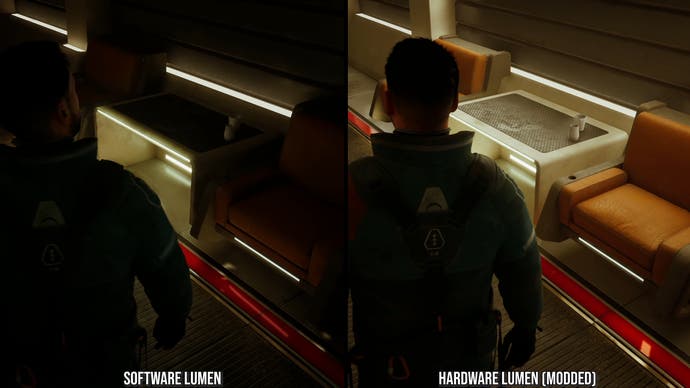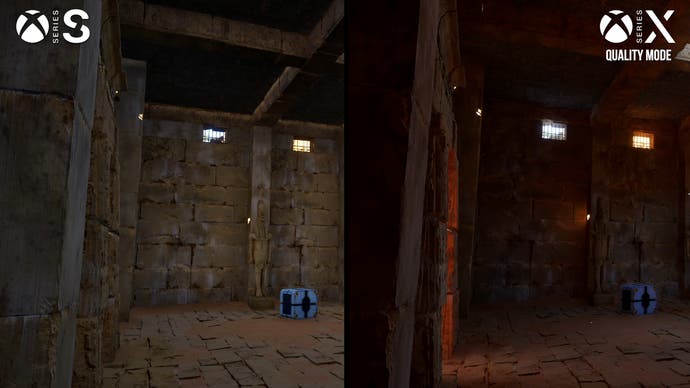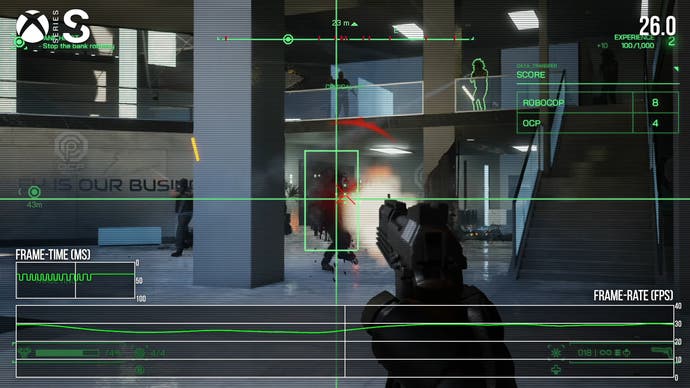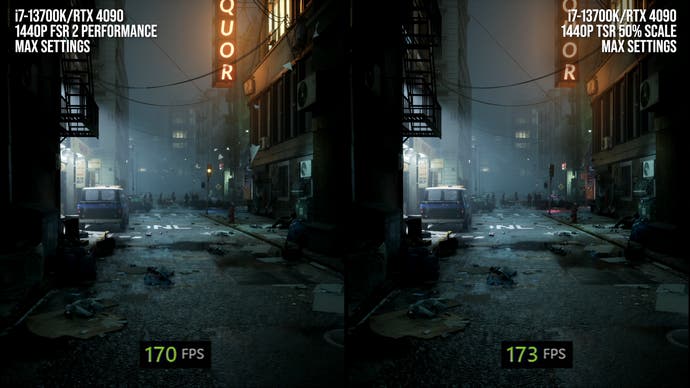
After years of ready, Unreal Engine 5 is lastly right here with a good roster of full video games to have a look at, past the tech demos and samples we had up to now. The early outcomes have been combined, with some titles exhibiting UE5’s deserves convincingly whereas others have been slowed down by picture high quality or efficiency issues. But there’s one query that hasn’t been answered fairly as effectively: how effectively do these applied sciences scale to console techniques? As we speak we’re trying on the present state of Unreal Engine 5 on PS5, Collection X and Collection S to judge how the know-how fares in early recreation efforts.
The important thing takeaway from my experiences with Unreal Engine 5 up to now is that the core characteristic set works. Lumen world illumination (GI) solves oblique lighting in actual time to a excessive diploma of constancy, producing great-looking shading in most circumstances when arrange accurately. Lumen reflections equally assist to gentle shiny and semi-gloss surfaces accurately, giving them handsome reflective element. Digital shadowmaps overcome the constraints of cascaded shadowmap methods to ship super-fine shadow element, with correct variable penumbra in some circumstances. In the meantime, Nanite delivers high-quality meshes with a steady stage of element system that simplifies asset manufacturing and prevents LOD popping.
Within the few video games the place these methods are mixed successfully, we do see a reasonably super uplift in visible high quality relative to video games on Unreal Engine 4. The lighting element in UE5 titles is excellent, even in video games which might be solely making use of the software program UE5 rendering mode, which is not utilizing {hardware} ray tracing. You get a lot of nice oblique lighting, reflections, and shadows, with every method displaying constancy that would not actually be replicable in a last-generation recreation. In broad strokes, the tech works. However once we do an in-depth have a look at among the console variations of those video games, the outcomes generally is a bit extra combined at occasions. We’ll have a look at PS5 and Collection X first, earlier than transferring onto Collection S later.
Fort Solis is an efficient instance. The sport’s Lumen GI is doing a little actually cool stuff right here, with areas which might be flooded with delicate illumination when lights activate and real-time bounce lighting from the participant flashlight. However there are different situations, the place we get a variety of breakup and artefacting within the Lumen GI, which is in its software program guise right here. I believe this exhibits the significance of getting these methods applied effectively, which might contain altering lighting preparations, eradicating emissive lights, or including extra direct lighting to the scene.
You would additionally merely improve the quantity of rays shot into the scene per pixel. We are able to see the flipside of this drawback once we put the sport into efficiency mode, the place the breakup and shimmer turns into a a lot better drawback. Growing the ray depend – or shifting the sport into the costlier {hardware} RT implementation of Lumen – may very well be past the capabilities of the console although, relying on the sport. The PC model of Fort Solis actually seems significantly better when modified to help {hardware} ray tracing, however that may have confirmed too costly on PS5.
The Talos Precept is one other latest UE5 title that exhibits off among the potential points with UE5 on consoles. There’s some stuff that is fairly cool right here – like super-fine shadow element courtesy of UE5’s digital shadowmap system. The Nanite geometry can also be very dense, and does not current with any LOD pop-in. Lumen reflections appear to have been omitted although, maybe as a consequence of focusing on consoles, although these reflections will be enabled on PC.

Most likely the most important points are associated to the Lumen GI, as soon as once more. The GI therapy can look fairly terrific right here, with an exquisite illustration of oblique illumination that could be a actual standout. However there are issues, like how foliage is badly over-darkened and lighting suffers from apparent breakup in some moments as effectively, with a spotty look. Within the absence of extra highly effective console {hardware}, you will note a few of these lighting points in not directly lit areas throughout titles that use Lumen.
Immortals of Aveum presents sure Lumen lighting points as effectively, principally associated to that over-darkening difficulty with software program Lumen. The coarseness of the signed distance fields (SDFs) offers us some very shade on the roots right here, which we would not see in actual life, although with much less nice geometry the outcomes are glorious. Once we hearth our spells at a wall, you possibly can see a crude, speckled impression of the sunshine on the ceiling. The outcomes listed below are principally respectable, however indirectly-illuminated scenes do expose some points.
With these video games I believe we see among the sensible limits of UE5 methods on consoles. Their energy constraints necessitate sure compromises for efficiency, which PC {hardware} is usually capable of overcome when given entry to increased settings choices.
I believe Robocop might be the best-adjusted of the latest UE5 crop on consoles. The lighting simply seems very good right here, and any Lumen points are saved to a minimal – usually, it’s important to exit of your technique to discover them. The sport additionally seems nice in its 60fps mode, even with a visibly decrease ray depend for Lumen GI, and we get strong Lumen reflections right here too. There are methods to get actually nice outcomes out of those methods even when you do not have a variety of {hardware} energy on faucet, although it does appear to require some cautious artist work.
Jusant is a captivating and well-designed latest UE5 recreation that is value highlighting as effectively. The sport makes use of very low-detail textures, so a variety of the color variation within the picture comes from oblique lighting. Gentle bounces by areas and swimming pools in crevices, with some terrific-looking imagery consequently. Software program Lumen’s exaggerations work fairly effectively on this context I believe, given the extra stylised artwork. Digital shadowmaps are highlighted successfully right here as effectively, lending pin-sharp and extremely detailed shadows to even essentially the most minor geometric components.
For a fast have a look at what the {hardware} RT path for UE5 could appear like on consoles, we have to make a journey again to 2021’s The Matrix Awakens demo. The Lumen oblique lighting element seems nice right here, and principally resolves with out seen noise. Reflections are the true standout right here although, as tracing towards triangles permits them to intently approximate the scene in a method that may’t actually be replicated with software program Lumen.

Visible high quality is barely half the story right here although, so what about efficiency? With the 30fps video games utilizing UE5, frame-rates are typically fairly constant. Robocop does throw up some drops in very intense motion, however in any other case there aren’t actually any points. At 60fps, there is a little bit of a spectrum: Jusant is sort of good, with very occasional one-off drops that appear like traversal stutters, whereas Immortals of Aveum is normally sub-60 and Lords of the Fallen suffers from profound stuttering points.
It isn’t completely clear what to chalk as much as UE5 although. As an illustration, Immortals of Aveum really runs so much higher on Collection S than Collection X, albeit at a a lot decrease decision, suggesting that the problems are primarily GPU-related. Simply setting the sport to a decrease decision would seemingly clear up a lot of the points that we’re seeing right here. The identical is probably going true for Robocop, which drops down fairly laborious throughout some extra intense battles however reveals respectable CPU efficiency on PC. I might a lot choose the builders of those video games set a extra conservative decision goal, as a substitute of presenting a variable efficiency stage.
Different points, just like the traversal stutters we see in lots of UE5 video games, appear extra intently linked to the engine know-how. These could also be more durable to beat, however reaching a usually good efficiency stage on consoles utilizing UE5 appears completely potential, judging from the ends in these early titles.

The opposite facet of the console query is how effectively video games scale to Collection S. I have been showcasing Collection X and PS5 up to now as a result of these consoles supply the canonical current-gen expertise, however UE5 video games do must scale to Microsoft’s 4TF cut-price console as effectively, with all of the difficulties that entails. It is weaker in GPU energy than some other current-gen console, and has a cut-back reminiscence association as effectively.
We see just a few approaches to focusing on Collection S right here. One possibility is to easily omit sure options that will not run effectively. The Talos Precept 2 excises Lumen GI on Collection S, as an illustration, which dramatically degrades the sport’s lighting presentation. We do not get the attractive occlusion and dramatic bounce that we see on Collection X. The builders of The Talos Precept 2 have really constructed a non-Lumen lighting pipeline for Collection S and lower-end PCs, utilizing easy fill lights to imitate world illumination, together with ambient occlusion, however the outcomes are removed from the Lumen-driven presentation on higher-end techniques. That additionally signifies that there isn’t any Lumen GI fallback for reflections on Collection S when the SSR is occluded.
We see an identical strategy in Robocop, the place Lumen reflections are lower on Collection S. The SDF-based reflections listed below are absent on the Collection S, which creates some points with occlusion, and produces a much less correct materials response on shiny and semi-gloss surfaces. Luckily, the Lumen GI is retained right here on the S, which is unquestionably the extra vital of the 2 methods on this recreation, though it has to make do with fewer rays. Epic’s Fortnite takes an identical tack, eradicating Lumen reflections from Collection S, and limiting digital shadowmap protection as effectively.

The opposite strategy is to retain these main UE5 visible options on Collection S and simply degrade their look as essential to maintain efficiency in examine. Jusant takes this path, reducing the decision of digital shadowmaps considerably, with extra seen stairstepping, and barely lowering the constancy of the Lumen GI. The Matrix Awakens is one other good instance; it positively has a variety of nips and tucks on Collection S should you look side-by-side, however you do retain all the important thing UE5 options, simply with an apparent lower in constancy and operating at a a lot decrease rendering decision. This will show the harder strategy, particularly if RAM constraints are an element.
Up to now, I believe UE5 video games have really scaled fairly effectively to the Collection S. There are apparent cuts, however I believe the system, for essentially the most half, preserves the important visible character of the higher-end console variations of those video games. The one exception within the video games I’ve examined can be The Talos Precept 2, which seems virtually generationally totally different at occasions due to the degraded lighting setup on Collection S. I believe retaining Lumen GI goes to be important for many video games.
Efficiency clever, the outcomes are principally much like the higher-end consoles. Jusant runs about the identical as its Collection X counterpart, whereas The Talos Precept runs barely worse. Immortals of Aveum really runs so much higher, with a reasonably strong 60fps replace, although this comes with a really low decision as a trade-off. Robocop solely has a 30fps mode on Collection S, and it does endure from extra frequent FPS dips, although it retains an affordable decision. I am not seeing large trigger for concern on the efficiency entrance on Collection S, although when it comes to visible options the outcomes are extra combined.

Upsampling is important to sustaining good efficiency in UE5. The engine’s key options scale straight with rendering decision, so excessive base resolutions are going to be out of the query for lots of UE5 efforts. To compensate on consoles, most builders are going to make use of one among two upsampling methods: FidelityFX Tremendous Decision 2, or Temporal Tremendous Decision, that are each supported in UE5 for console use.
Robocop’s PC construct helps each methods, making it an excellent testbed to see which might work effectively on console. With a reasonably demanding 720p to 1440p upscale, each methods do an okay job in stills – although you possibly can observe some extra breakup with FSR 2 in just a few locations within the picture. However when really transferring by the sport world, there is a fairly stark distinction in favour of the TSR method right here. Neither is producing a complete anti-aliased picture thoughts you, however the TSR is so much cleaner in typical play.
This distinction is magnified once we do a easy horizontal pan with none movement blur. FSR 2 has a super-aliased, extremely noisy picture below this type of digicam motion, whereas TSR retains shimmer just about below management, with out obtrusive artefacting. I additionally seen that the TSR tends to have fewer ghosting artefacts on this recreation.

By way of efficiency, TSR additionally barely outperforms FSR 2 right here, clocking in with a small benefit at 1440p output in efficiency mode and at 4K in high quality mode. These methods can differ in high quality a bit from title to title, so this should not be taken as a dispositive verdict on the relative deserves of the 2 methods, however it actually looks like TSR would be the more sensible choice on consoles. Even with a reasonably heavy upscale issue right here, it is producing a superbly handsome ultimate picture – one that might maintain up decently from a typical viewing distance on a 4K show.
Finally, I believe we’re seeing some principally constructive indications from UE5 in console video games. The core graphical tech clearly scales effectively to console {hardware}, delivering some actually spectacular visible ends in drawback areas for real-time rendering. A recreation like Robocop is delivering top-tier console visuals with the assistance of UE5, as an illustration. On the efficiency entrance, some video games do wrestle, although in some circumstances this appears to be extra by the hands of the developer than the UE5 instruments.
Efficiency in future video games will show extra attention-grabbing. This early crop of titles principally consists of lower-budget fare and we’ve not seen a variety of big-budget AAA efforts to essentially stress the engine tech. Can a recreation that options super-detailed Nanite meshes and complicated character fashions hit a strong frame-rate on consoles, particularly when aiming for 60fps? Will big-budget video games sidestep or overcome the traversal stutter points usually related to Unreal? And might they obtain handsome visuals on Collection S whereas retaining key UE5 tech? I do not assume we now have good solutions to those questions, however they need to be forthcoming over the subsequent yr or two.
